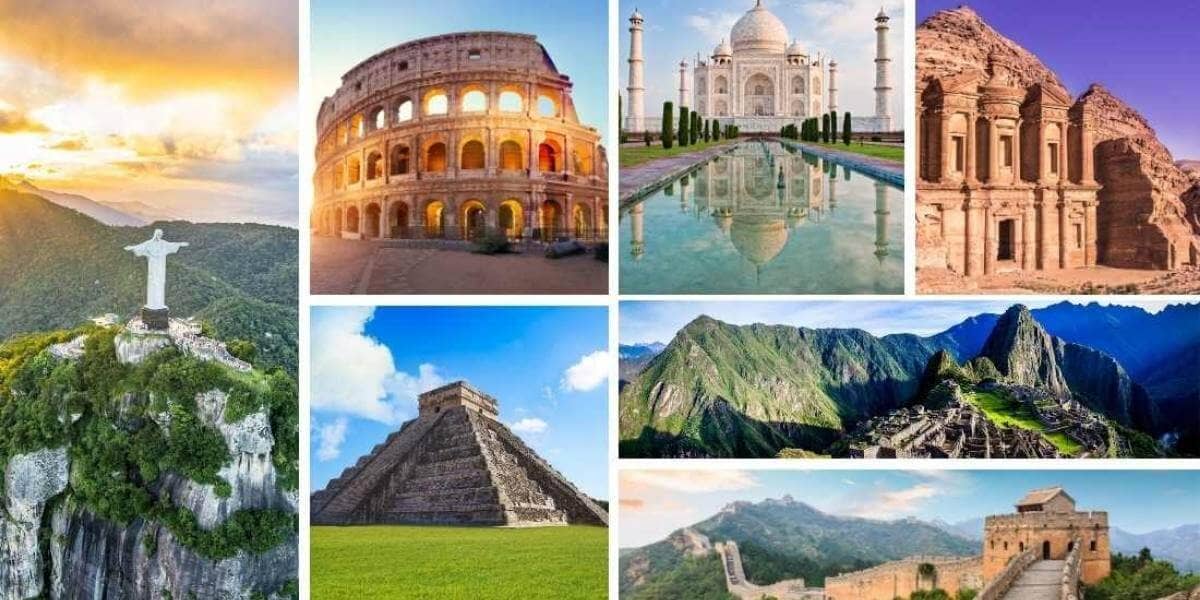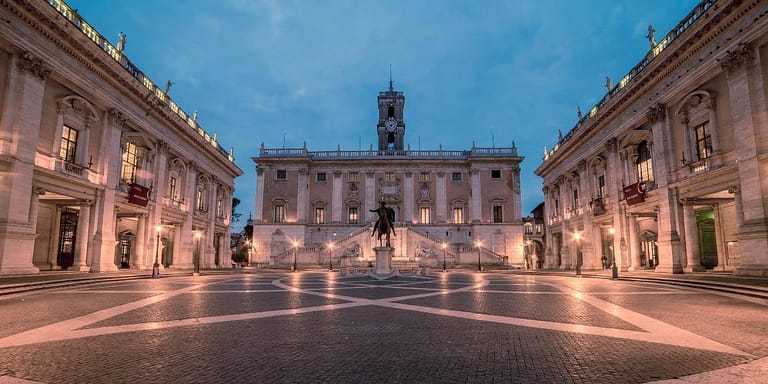The 7 New Wonders of the World
As someone who loves learning about ancient cultures and visiting historical sites, I find the Seven Wonders of the Ancient World a fascinating wishlist of places I would love to see. Unfortunately, only one still stands today – the Great Pyramid of Giza in Egypt. So what, then, are the New Wonders of the World and how did they come to be? The answer might surprise you.
The search for the Seven New Wonders of the World began in 2001 as a private initiative led by Bernard Werber. His vision was to involve people from around the world in the selection process. He succeeded beyond his wildest dreams – more than 90 million people participated in the vote, considering 200 different submissions. The final seven were finally announced in 2007, marking a significant milestone in the world of historical and architectural preservation.
Affiliate Disclosure – This post contains affiliate links. If you make a purchase through these links, I may earn a commission. This doesn’t affect your purchases or any fees you may pay for the product or service. Read more in my DISCLAIMER.
The Seven New Wonders of the World
The Seven New Wonders of the World are all monumental structures spread across four continents that were constructed by ancient empires. They are also accessible today and attract visitors from across the world. All seven are UNESCO World Heritage Sites, recognized for their cultural and historical value, although UNESCO had no affiliation with the competition.
Whether you’re a history buff, an architecture aficionado like me, or simply someone who appreciates the power and majesty of the human spirit, a visit to any of the Seven New Wonders of the World is sure to leave an indelible mark on your soul.
If you enjoy reading about the 7 New Wonders of the World, you might like Canada’s 20 UNESCO World Heritage Sites.
The Great Wall of China
Location: China | Date of construction: 220 B.C. to 1644 A.D.
The Great Wall of China is an impressive landmark stretching almost 9,000 km (over 5,500 miles) across China. It was first built to protect China from raids and invasions from the northern tribes, particularly the Mongols. It was built and rebuilt over many centuries, with different ancient Chinese states constructing sections of the wall during the early days of its construction.
The wall was initially made from simple materials such as earth, wood and stones. Over time, however, it became a more sophisticated structure when bricks and stone masonry were added. To make the wall more effective, various defensive barriers, such as trenches, hills and rivers, were added, bringing the total length of the wall to over 21,000 km (over 13,000 miles).
The first Chinese emperor, Qin Shi Huang (220–206 B.C.), is credited with connecting the different sections of the wall built by the various states and making it into a unified defence system. The wall continued to be fortified and extended by subsequent dynasties, with the most well-known and preserved walls dating back to the Ming dynasty (1368–1644). The wall was extended and rebuilt during the Ming dynasty with bricks and tamped earth. Watchtowers were added to enable the military to monitor and defend the border.
The Great Wall of China is not only an architectural marvel, but it also has great historical and cultural significance. It represents the ingenuity and engineering skills of the Chinese people and their determination to protect their country from external threats. The wall has also played a significant role in the politics and culture of China. It’s been the subject of many legends, poems and paintings over the centuries.
The Great Wall draws millions of visitors each year. It is the most popular tourist attraction in China and one of the most impressive landmarks in the world. You can access the wall in different locations, Badaling near Beijing being the most popular.
I visited the Great Wall of China a few years ago, which was an incredible experience. The steps were a lot steeper than I anticipated and very uneven. While the wall was quite impressive, the surrounding area was slightly unremarkable. At that time, the greenery usually seen in images was done for the season, so everything looked dull and brown.
Petra
Location: Jordan | Date of construction: c. 100 B.C.
If you haven’t yet been to the stunning old city of Petra, you probably have it on your bucket list. Or you might remember it from the movie Indiana Jones and the Last Crusade. No matter how you look, the stunning site carved out of pink, orange and red sandstone includes the Treasury (Al-Khazneh), Monastery and Great Temple. The site attracts over a million visitors annually (2019 numbers). So far, only 15% of what’s hidden here has been uncovered. We can only imagine what secrets are hidden here.
Petra was once the home to the Nabataean empire of King Aretas IV (9 B.C. to A.D. 40) and a significant center of trade and commerce in the ancient world. Petra’s strategic location at the crossroads of major trade routes between Arabia, Egypt, and Syria made it a hub for commerce and cultural exchange.

Its sophisticated water system once sustained more than 30,000 people who lived here. Petra eventually fell to the Romans and became known as the Arabia Petraea. It ultimately suffered damage during an earthquake in 363. The city continued to decline during the Byzantine times due to a decline in trade and eventually became forgotten.
The Swiss traveller and geographer Johann Ludwig Burckhardt rediscovered Petra in 1812. In 1985, UNESCO inscribed Petra as a World Heritage Site, thanks to its outstanding universal value of elaborate tombs and architecture. I have yet to go to Petra, but it’s very high on my bucket list.
Enjoying this post? You might like 15 Awesome people who changed the world of travel!
Christ the Redeemer
Location: Brazil | Date of construction: 1922 to 1931.
The Art Deco statue of Christ the Redeemer is an iconic symbol of Rio de Janeiro in Brazil, and it’s the youngest member of the New Wonders of the World list. The figure stands atop Corcovado Mountain at 98 feet (30 metres) high on a pedestal that measures 26 feet (8 metres). The Christ’s arms stretch 92 feet (28 metres) wide, and the statue is visible from almost every part of the city.
The statue was constructed between 1922 and 1931 and was created as a symbol of Brazilian Christianity. It is considered one of the largest art deco statues in the world and is made of reinforced concrete and soapstone. It has become a symbol of Brazil and an important tourist attraction, attracting millions of visitors each year who come here to admire its beauty and take in the breathtaking views of the city below.

The idea of placing a religious monument on top of the mountain was first floated around by a priest during the 1850s. It didn’t entirely take off until the 1920s with a push of a Catholic organization that also helped to raise funds. The Christ was unveiled in 1931 and has been standing with open arms over Rio since then.
The statue is imposing and impressive, especially when you consider its location. However, the views of Rio are even more breathtaking as you stand under the statue. I went early in the morning to avoid the crowds, which was worth getting up for. Bucket list item, check. Morning is also a great time to visit, especially if you’re visiting during the summer, as the sun can get scorching as the day goes by.
Machu Picchu
Location: Peru | Date of construction: c. 1450 A.D.
Machu Picchu, a pre-Columbian Inca settlement nestled high in the Peruvian Andes, is one of the most iconic archaeological sites in the world. The site has captivated people since its rediscovery in 1911 by the American explorer Hiram Bingham. Today, it’s on the bucket list of many travellers, myself included.
While the origins and purpose of Machu Picchu continue to puzzle experts, one thing is clear: it was a remarkable achievement of Incan engineering and architecture. Theories about its original use range from being a royal retreat for the Incan emperor Pachacuti Inca Yupanqui to a sacred pilgrimage site. The site was abandoned during the mid-16th century, and its existence was largely forgotten until Bingham’s discovery.

Today, Machu Picchu attracts so many tourists that the local government has implemented visitor limits to prevent damage. This awe-inspiring site can be reached by hiking up the Incan trail, a challenging but rewarding journey, or by train, which offers a more comfortable and leisurely option. Whatever your method of arrival, experiencing the wonder and beauty of Machu Picchu is an unforgettable experience that provides insight into the remarkable cultural and architectural achievements of the ancient Incas.
Chichen Itza
Location: Mexico | Date of construction: c. 600 A.D.
Chichen Itza was an ancient Mayan city in what today is the Yucatán Peninsula in Mexico. This was the centre and religion, and power of the Maya and then the Maya-Toltec civilization. Although it was a flourishing place around the 9th and 10th centuries, it was abandoned when the Spanish found it in the 16th century.
Today, several monuments survive, including the Warriors’ Temple, El Caracol observatory and the stepped pyramid El Castillo (or the Temple of Kukulkán). The symmetrical temple rises 79 feet (24 meters) above, with 365 steps, each representing a day in the Mayan calendar. They represent the Mayan innovation in astronomy and science.

The site deteriorated due to elements after it was abandoned. Archaeological excavations in 1841 brought the city to light once again where you can learn more about this ancient culture. Today, Chichen Itza is a designated protected archeological monument on the UNESCO World Heritage Site list.
Colosseum
Location: Italy | Date of construction: 70 to 80 A.D.
The Colosseum (aka Flavian Amphitheatre) is as iconic as Rome itself. This amphitheatre is an architectural marvel commissioned by Emperor Vespasian around 70 A.D. and completed by his successor Titus in 80 A.D. Built out of brick-faced concrete, tuff and travertine limestone, the Colosseum could hold between 50,000 to 80,000 spectators.
The Romans gathered here to watch public spectacles, mock sea battles and gladiators who battled each other and the wild beasts brought in for that purpose. Its ingenious design included a retractable awning that could shelter audiences from the elements and the hypogeum (the underground) that we see today. An elaborate network of tunnels and cages beneath the arena allowed men and beasts to be brought onto the stage for entertainment.

Today’s Colosseum is a shadow of its former glory, damaged by earthquakes, fires, and looting over time. While it’s important to praise its architectural design, it’s also worth noting that thousands of people and animals were slaughtered here for entertainment. Today, you might see crosses at the Colosseum. That’s because, in 1749, Pope Benedict XIV consecrated the building as a sacred site to commemorate the many Christians that were killed there.
Taj Mahal
Location: India | Date of construction: 1632 to 1648 A.D.
The ivory-white marble complex of the Taj Mahal is easily recognizable around the world today. With a blend of numerous architectural styles, including Persian, Islamic, Turkish and Indian, it is considered a jewel of Muslim art and a testament to the grandeur of Mughal architecture in India.

Emperor Shah Jahan commissioned the Taj Mahal in 1632 to honour his favourite wife, Mumtaz Mahal. She died in childbirth in 1631. The mausoleum construction took over two decades and more than 20,000 workers. The complex includes formal gardens and a reflecting pool.
The Taj Mahal is on the list of Seven New Wonders of the World and was designated a UNESCO World Heritage Site in 1983. It is a universally admired example of an architectural masterpiece and attracts anywhere between seven and eight million visitors annually.
Enjoy reading about the 7 New Wonders of the World? You might like to read about Qutub Minar, another UNESCO site in India!
Final Thoughts on the 7 New Wonders of the World
In away, it makes me sad the Great Pyramid of Giza is the only remaining wonder of the ancient world. But, it’s significance is still so relevant that it was added to the list of New World Wonders as an honorary candidate. That is also why you might often hear eight, not seven, New Wonders of the World. I think that’s a fitting solution.
As with any contest of this kind, there are many awe-inspiring wonders out there that didn’t make the final cut. Understandably, not everyone agreed with the selection or felt that other, well-deserving places should be on the list. Whether you use the New Wonders of the World list as your motivation or not, these seven places are worthy of admiration.
The idea of identifying world wonders has led to the creation of other lists—the architectural wonders, the wonders of nature, the wonders of the industrial world and so on. No matter what the list is, there are always seven items on it. The number seven represented perfection to the Greeks, who came up with the original bucket list. Seven also represents the five planets that the ancients knew, plus the sun and the moon. So, there you have it.
Travel Resources
Planning your next trip? Check out the resources I use and start planning your perfect getaway today!
- Flights: Find the best flight deals on Kiwi.com (my new go-to for flights)
- Book your accommodations: Find the best prices on hotels with Booking.com
- What to do: Find the perfect tour with Viator
- Need a car? Book your ride with Rentalcars.com
Check out my travel resource guide for more resources to help you plan your trip.









